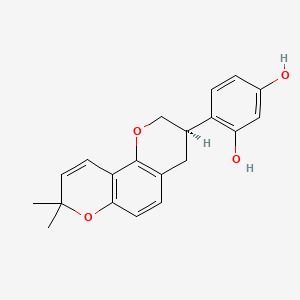
|
Glabridin |
Glabridin is a lipid of Polyketides (PK) class. Glabridin is associated with abnormalities such as Atherosclerosis, CNS disorder, Corn of toe, Fatty Liver and Obesity. The involved functions are known as Energy Absorption, Oxidation, Oxidants, Metabolic Process, Cellular and Drug Interactions. Glabridin often locates in Hepatic, membrane fraction, Microsomes, Microsomes, Liver and Extracellular. The associated genes with Glabridin are P4HTM gene, SPEN gene, SLC33A1 gene, ABCB1 gene and CD9 gene. The related lipids are Nonesterified Fatty Acids, Total cholesterol, Lipopolysaccharides, Hydroxycholesterols and 7-ketocholesterol. The related experimental models are Mouse Model. |
263 |

|
HEMATOXYLIN |
HEMATOXYLIN is a lipid of Polyketides (PK) class. Hematoxylin is associated with abnormalities such as Eosinophilia, Duodenal Adenoma, Senile Plaques, Morphologically altered structure and Cervical abscess. The involved functions are known as Uptake, Apoptosis, Amplification, Necrosis and Karyopyknosis. Hematoxylin often locates in Body tissue, Extracellular, Compact bone, Skin and Basement membrane. The associated genes with HEMATOXYLIN are GAPDH gene, Genome, Elastin, MERTK wt Allele and P4HTM gene. |
6127 |
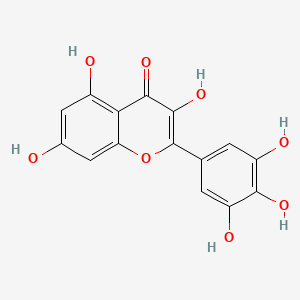
|
myricetin |
myricetin is a lipid of Polyketides (PK) class. Myricetin is associated with abnormalities such as Diabetes, First myocardial infarction, Diabetes Mellitus, Non-Insulin-Dependent, Asthma and Cataract. The involved functions are known as Cell Survival, inhibitors, Process, Metabolic Inhibition and Oxidation. Myricetin often locates in Fibril - cell component, soluble, Body tissue, Back and Tissue membrane. The associated genes with myricetin are HPGDS gene, P4HTM gene, CFLAR gene, SLC2A2 gene and SLC2A1 gene. The related lipids are Promega, Sterols, dipalmitoylphosphatidylserine, 1,2-oleoylphosphatidylcholine and Membrane Lipids. |
1801 |

|
quercetin |
quercetin is a lipid of Polyketides (PK) class. Quercetin is associated with abnormalities such as Coronary heart disease, Myocardial Infarction, Cirrhosis, Coronary Arteriosclerosis and Vascular ring. The involved functions are known as Vasodilation, physiological aspects, Fermentation, Process and Ingredient. Quercetin often locates in Arterial system, Endothelium, Skin, Endothelium, Vascular and Tissue specimen. The associated genes with quercetin are P4HTM gene, SULT gene, UGT1A1 gene, ARHGAP26 gene and PLXNB1 gene. The related lipids are blood lipid, Promega, Steroids, Phosphatidylserines and Fatty Acids. The related experimental models are Knock-out, Mouse Model, Xenograft Model, Tissue Model and Cancer Model. |
5377 |

|
apigenin |
apigenin is a lipid of Polyketides (PK) class. Apigenin is associated with abnormalities such as Morphologically altered structure, Chimera disorder, Hypertensive disease, infection induced and Infection. The involved functions are known as inhibitors, Gene Expression, Process, Metabolic Inhibition and Cell Death. Apigenin often locates in Vacuole, Cytoplasmic matrix, Cytoplasm, Tissue membrane and Membrane. The associated genes with apigenin are MSMP gene, BCL2 gene, PTGS2 gene, Chromatin and SLC33A1 gene. The related lipids are Lipopolysaccharides, Steroids, 1-Butanol, agosterol A and Butyrates. The related experimental models are Mouse Model, Tissue Model, Knock-out, Xenograft Model and Disease model. |
4250 |

|
FLAVONE |
FLAVONE is a lipid of Polyketides (PK) class. Flavone is associated with abnormalities such as Cardiovascular Diseases, Cerebrovascular accident, DERMATITIS HERPETIFORMIS, FAMILIAL, Hyperinsulinism and Inflammatory disorder. The involved functions are known as Oxidation-Reduction, Metabolic Inhibition, Inflammation, Phosphorylation and antioxidant activity. Flavone often locates in Endothelium, Hepatic, Protoplasm, Body tissue and Extracellular. The associated genes with FLAVONE are ICAM1 gene, BCL2L1 gene, MYC gene, TP53 gene and cytochrome c''. The related lipids are Promega, Steroids and Total cholesterol. The related experimental models are Knock-out, Disease model and Animal Disease Models. |
2093 |
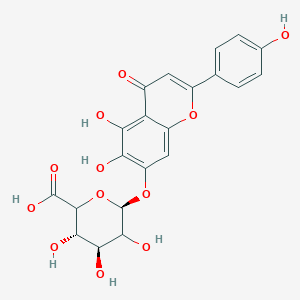
|
Scutellarein 7-glucuronide |
Scutellarein 7-glucuronide is a lipid of Polyketides (PK) class. |
184 |

|
luteolin |
luteolin is a lipid of Polyketides (PK) class. Luteolin is associated with abnormalities such as Morphologically altered structure, Nodule, retinal toxicity, CLEFT LIP, CONGENITAL HEALED and Ischemia. The involved functions are known as Metabolic Inhibition, Cell Death, Caspase Activation, activation of protein kinase C activity by G-protein coupled receptor protein signaling pathway and protein kinase C activity. Luteolin often locates in Mitochondria, Cell-Free System, Protoplasm, Membrane and Body tissue. The associated genes with luteolin are BCL2 gene, TNFSF10 gene, BCL2L1 gene, XIAP gene and MCL1 gene. The related lipids are Lipopolysaccharides, Sterols, blood lipid, Fatty Acids and Steroids. The related experimental models are Xenograft Model, Mouse Model, Experimental Autoimmune Encephalomyelitis, Knock-out and Cancer Model. |
3284 |
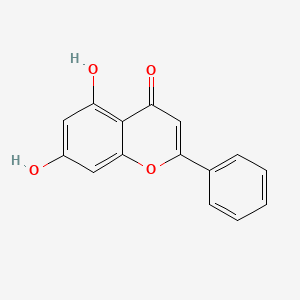
|
chrysin |
chrysin is a lipid of Polyketides (PK) class. Chrysin is associated with abnormalities such as Unconjugated hyperbilirubinemia, Metabolic Diseases, Hypogonadism, Renal tubular disorder and Colitis. The involved functions are known as Hypoxia, enzyme activity, Oxidation, inhibitors and Cell Survival. Chrysin often locates in Protoplasm, Plasma membrane, Back, Extracellular and Mitochondria. The associated genes with chrysin are CFB gene, P4HTM gene, UGT1A9 gene, CYP1A1 gene and UGT1A1 gene. The related lipids are Promega, estradiol-3-glucuronide, Steroids and Lipopolysaccharides. The related experimental models are Mouse Model. |
1085 |

|
baicalein |
baicalein is a lipid of Polyketides (PK) class. Baicalein is associated with abnormalities such as Neurodegenerative Disorders, Fibrillation, Hypertensive disease, Aortic coarctation and Coronary Occlusion. The involved functions are known as Anabolism, Polymerization, Process, inhibitors and Pathogenesis. Baicalein often locates in Membrane, Lipid Bilayers, soluble, Cell-Free System and Protoplasm. The associated genes with baicalein are P4HTM gene, BIRC5 gene, TSPO gene, SHOC2 gene and XIAP gene. The related lipids are Fatty Acids, Nonesterified Fatty Acids, iodoresiniferatoxin, Lipopolysaccharides and 17-octadecynoic acid. The related experimental models are Knock-out, Mouse Model and Parkinsonism, Experimental. |
1997 |
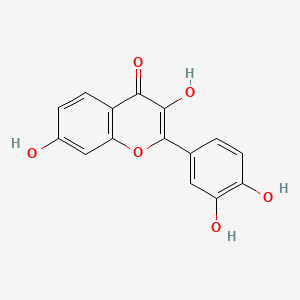
|
Fisetin |
Fisetin is a lipid of Polyketides (PK) class. Fisetin is associated with abnormalities such as Morphologically altered structure, PARKINSON DISEASE, LATE-ONSET, Tetanus, CNS disorder and Disintegration (morphologic abnormality). The involved functions are known as Autophagy, Apoptosis, Energy Metabolism, Acceleration and Anabolism. Fisetin often locates in Mitochondria, Cytoplasmic matrix, Extracellular, Cytoskeletal Filaments and Autophagic vacuole. The associated genes with Fisetin are SIRT1 gene, MAP1LC3A gene, TP53 gene, P4HTM gene and AURKB gene. The related lipids are Phosphatidylserines and Lipopolysaccharides. The related experimental models are Animal Cancer Model, Xenograft Model, Mouse Model, Cancer Model and Disease model. |
832 |
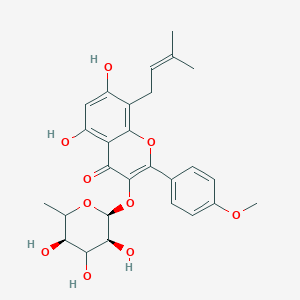
|
Baohuoside 1 |
Baohuoside 1 is a lipid of Polyketides (PK) class. |
130 |
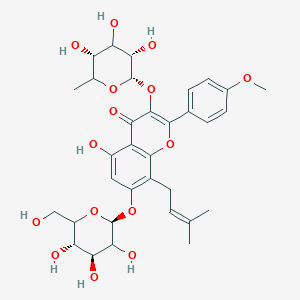
|
LMPK12112009 |
LMPK12112009 is a lipid of Polyketides (PK) class. |
216 |
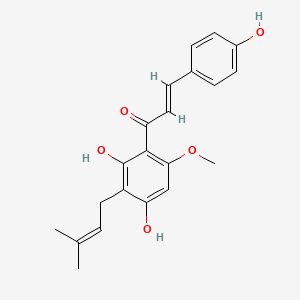
|
Xanthohumol |
Xanthohumol is a lipid of Polyketides (PK) class. Xanthohumol is associated with abnormalities such as Endometriosis, site unspecified, Cyst, peritoneal lesion, Proliferative inflammation and furuncle. The involved functions are known as Cell Proliferation, Signal Transduction, Pathologic Neovascularization, Adverse effects and Proliferation (morphologic abnormality). Xanthohumol often locates in peritoneal, Mesentery, Membrane, Tissue specimen from uterus and Cell Nucleus. The associated genes with Xanthohumol are PI3 gene, KEAP1 gene, SLC33A1 gene, BCR-ABL Fusion Gene and BIRC5 gene. The related lipids are Fatty Acids and Palmitates. The related experimental models are Knock-out. |
465 |
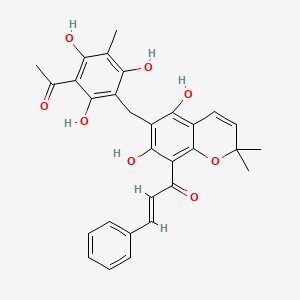
|
rottlerin |
Rottlerin is a lipid of Polyketides (PK) class. Rottlerin is associated with abnormalities such as PARAGANGLIOMAS 2, Hyperostosis, Diffuse Idiopathic Skeletal, Virus Diseases, Perisylvian syndrome and Autoimmune disease (systemic) NOS. The involved functions are known as Apoptosis, Regulation, Signal Transduction, inhibitors and Proteasome Inhibitors [MoA]. Rottlerin often locates in Clone, Membrane, Body tissue, Plasma membrane and soluble. The associated genes with Rottlerin are XIAP gene, GAPDH gene, ICAM1 gene, P4HTM gene and TNFSF10 gene. The related lipids are Promega, Fatty Acids, Sphingolipids, Lipopolysaccharides and Saponin. The related experimental models are Mouse Model, Xenograft Model and Cancer Model. |
1198 |
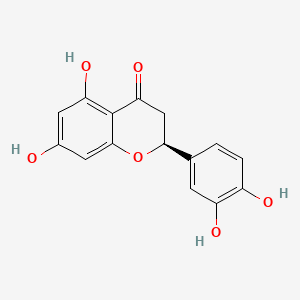
|
ERIODICTYOL |
Eriodictyol is a lipid of Polyketides (PK) class. Eriodictyol is associated with abnormalities such as Hyperostosis, Diffuse Idiopathic Skeletal, Macular degeneration, Consumption-archaic term for TB, Retinal Diseases and PARAGANGLIOMAS 4. The involved functions are known as glutathione biosynthetic process, Cytoprotection, Oxidants, protein expression and Cell Survival. Eriodictyol often locates in Cytoplasmic matrix, Protoplasm, Cytoplasmic, Cell Fraction and Back. The associated genes with Eriodictyol are NQO, HMOX1 gene, IMPACT gene, RPS6KA3 gene and GDNF gene. |
311 |
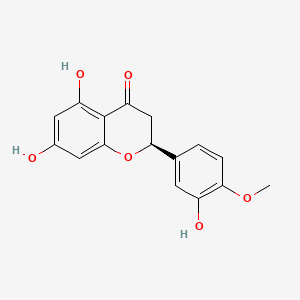
|
hesperetin |
Hesperetin is a lipid of Polyketides (PK) class. Hesperetin is associated with abnormalities such as Corn of toe, Ischemia, Osteoporosis, Consumption-archaic term for TB and Wiskott-Aldrich Syndrome. The involved functions are known as conjugation, inhibitors, Process, mRNA Expression and Adjudication. Hesperetin often locates in Entire intestinal epithelium, Protoplasm, Membrane, Shoulder and Back. The associated genes with Hesperetin are ABCG2 gene, ABCC2 gene, FATE1 gene, ABCB1 gene and P-glycoprotein 2. |
801 |
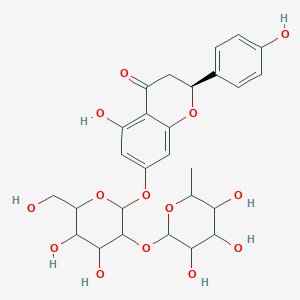
|
NSC5548 |
NSC5548 is a lipid of Polyketides (PK) class. Nsc5548 is associated with abnormalities such as Diabetes Mellitus, Non-Insulin-Dependent, Hyperglycemia, Coronary Arteriosclerosis, Liver diseases and Pulmonary Edema. The involved functions are known as Increased Sensitivy, Taste Perception, Cell Death, Phosphorylation and Signal Transduction. Nsc5548 often locates in Oral region, Cytoskeleton, Hepatic, Blood and Mouse Bone Marrow. The associated genes with NSC5548 are CA2 gene, P4HTM gene, FPGT gene, glycyl-L-phenylalanine and glycylphenylalanine. The related lipids are butyrate, Lipid Peroxides, blood lipid, Sterols and Total cholesterol. |
283 |
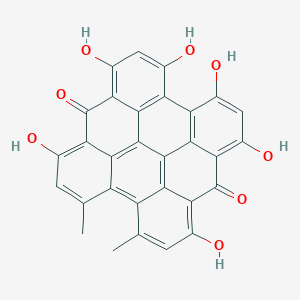
|
hypericin |
hypericin is a lipid of Polyketides (PK) class. Hypericin is associated with abnormalities such as Dermatitis, Phototoxic, Dehydration, Photosensitization, Morphologically altered structure and Myocardial Infarction. The involved functions are known as Cell Cycle Checkpoints, Apoptosis, Acetylation, Cell Survival and Caspase Activation. Hypericin often locates in insoluble fraction, Cytoplasmic matrix, Protoplasm, Tissue membrane and Cytoplasm. The associated genes with hypericin are CDC37 gene, HSPA8 gene, RAF1 gene, cyclin H and FK228. The related lipids are Phosphatidylserines. |
1752 |
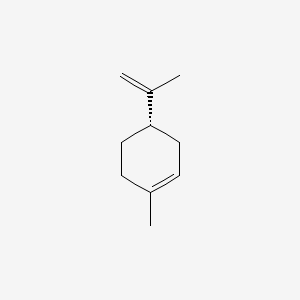
|
(-)-Limonene |
(-)-limonene is a lipid of Prenol Lipids (PR) class. (-)-limonene often locates in Kinetochores. |
1786 |
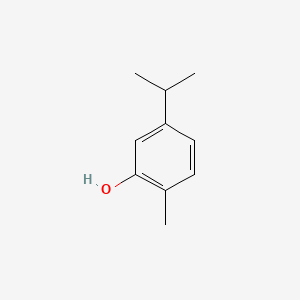
|
Carvacrol |
Carvacrol is a lipid of Prenol Lipids (PR) class. Carvacrol is associated with abnormalities such as Consumption-archaic term for TB, Disintegration (morphologic abnormality), Infection, Corn of toe and Candidiasis of vagina. The involved functions are known as Stereochemistry, Anabolism, Oxidation, Process and Binding (Molecular Function). Carvacrol often locates in Skin, Nerve Tissue, Membrane, Endothelium and Plasma membrane. The associated genes with Carvacrol are P4HTM gene, TRPV3 gene, TRPV1 gene, TRPV2 gene and TRPV4 gene. The related lipids are Fatty Acids, Lipopolysaccharides, Octanols, Micelles and butyrate. |
1535 |

|
Thapsigargin |
Thapsigargin is a lipid of Prenol Lipids (PR) class. Thapsigargin is associated with abnormalities such as Impaired glucose tolerance, Obesity and Blood Pressure Disorders. The involved functions are known as Phosphorylation, establishment and maintenance of localization, Regulation, Metabolic Inhibition and Proteolysis. Thapsigargin often locates in Mouse Skin, Cytoplasm, Skin, Protoplasm and Mitochondria. The associated genes with Thapsigargin are ERBB4 gene, F11 gene, CA1 gene, TRNAP1 gene and HSPA5 gene. The related lipids are taurolithocholic acid 3-sulfate, Liposomes, Fatty Acids and stearylamine. The related experimental models are Mouse Model. |
8868 |

|
forskolin |
Forskolin is a lipid of Prenol Lipids (PR) class. Forskolin is associated with abnormalities such as Cholestasis, Vocal cord dysfunction familial, Hypothyroidism, Renal tubular disorder and Disintegration (morphologic abnormality). The involved functions are known as Cell Proliferation, Anabolism, mRNA Expression, Agent and Signal. Forskolin often locates in Extracellular, Body tissue, Skin, Tissue membrane and Membrane. The associated genes with forskolin are P4HTM gene, SLC33A1 gene, NR1I2 gene, Genes, Reporter and CYP3A gene. The related lipids are Steroids, steroid sulfate, Fatty Acids, LYSO-PC and Lipopolysaccharides. |
24755 |
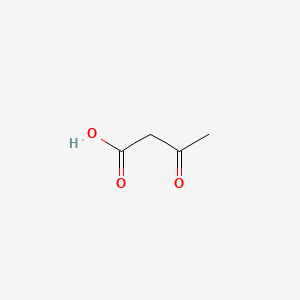
|
Acetoacetic acid |
Acetoacetic acid is a lipid of Fatty Acyls (FA) class.Acetoacetic acid is associated with abnormalities such as Dehydration. The involved functions are known as Biochemical Reaction, intracellular signal transduction, fatty acid elongation, Cytokinesis and Mass-to-Charge Ratio. The associated genes with Acetoacetic acid are CFB gene and mersacidin. Acetoacetic acidis associated with Carbon, Acids, Potassium, Acetoacetic acid and Oximes. The related lipids are Nonesterified Fatty Acids and Stearates. |
2523 |

|
phorbol 13-acetate 12-myristate |
Phorbol 13-acetate 12-myristate is a lipid of Prenol Lipids (PR) class. The involved functions are known as DNA Fragmentation, Phosphorylation and Irritation. Phorbol 13-acetate 12-myristate often locates in low-density lipoprotein particle. The associated genes with phorbol 13-acetate 12-myristate are FPR1 gene and ABCB1 gene. |
40921 |

|
Sphingosine 1-phosphate |
Sphingosine 1-phosphate is a lipid of Sphingolipids (SP) class. Sphingosine 1-phosphate is associated with abnormalities such as Infection, Painful Bladder Syndrome, Atherosclerosis, Hyperglycemia and Rheumatoid Arthritis. The involved functions are known as Phosphorylation, Regulation, enzyme activity, Energy Absorption and Vascular Permeability. Sphingosine 1-phosphate often locates in Endothelium, Tissue membrane, Vascular System, Protoplasm and Microfilaments. The associated genes with Sphingosine 1-phosphate are MBTPS1 gene, FBXL15 gene, TEK gene, NTRK1 gene and Gene Family. The related lipids are Promega, Lipopolysaccharides, lysophosphatidic acid, Lysophosphatidylcholines and Lysophospholipids. The related experimental models are Knock-out, Mouse Model, Transgenic Model, Disease model and Experimental Autoimmune Encephalomyelitis. |
2005 |

|
cholesterol |
cholesterol is a lipid of Sterol Lipids (ST) class. Cholesterol is associated with abnormalities such as Trypanosomiasis, Chagas Disease, Cleft Palate, Chondrodysplasia punctata 2, X-linked dominant and Child syndrome. The involved functions are known as Blood Circulation, Sterol Biosynthesis Pathway, Receptor Mediated Endocytosis, Methylation and Signal. Cholesterol often locates in Animal tissue, Blood, Membrane, Plasma membrane and peroxisome. The associated genes with cholesterol are MBD2 gene, SIM, SLC33A1 gene, Genome and NSDHL gene. The related lipids are Sterols, zymosterol, fecosterol, Total cholesterol and 7-dehydrocholesterol. The related experimental models are Mouse Model, Knock-out, Genetically Engineered Mouse and Disease model. |
98461 |
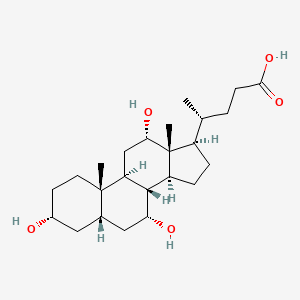
|
Cholic acid |
Cholic acid is a lipid of Sterol Lipids (ST) class. Cholic acid is associated with abnormalities such as Cholestasis, Intrahepatic Cholestasis, Atherosclerosis, Diabetes and cholesterol gallstones. The involved functions are known as Homeostasis, Enterohepatic Circulation, Proliferation (morphologic abnormality), Process and Cell Proliferation. Cholic acid often locates in Hepatic, Cytoplasmic matrix, Membrane, Protoplasm and Tissue membrane. The associated genes with Cholic acid are CYP27A1 gene, ABCB11 gene, NR5A2 gene, SLC10A2 gene and SLC10A1 gene. The related lipids are ursocholic acid, Steroids, Cholestenes, Cholestanes and cholanic acid. |
3054 |
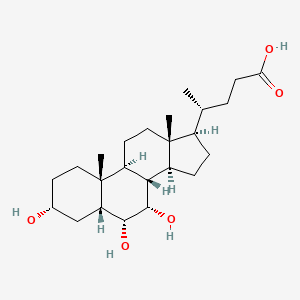
|
Hyocholic acid |
Hyocholic acid is a lipid of Sterol Lipids (ST) class. |
48 |
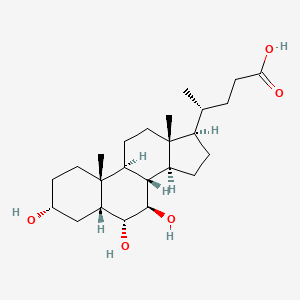
|
Omega-muricholic acid |
Omega-muricholic acid is a lipid of Sterol Lipids (ST) class. |
29 |
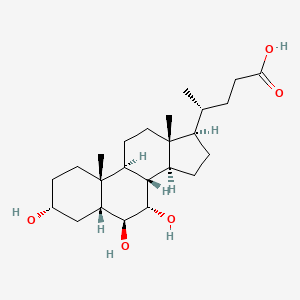
|
Alpha-muricholic acid |
Alpha-muricholic acid is a lipid of Sterol Lipids (ST) class. |
29 |
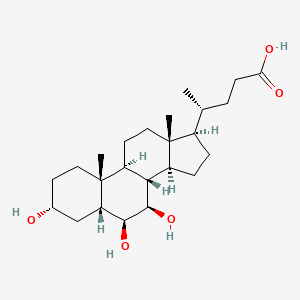
|
Beta-muricholic acid |
|
39 |
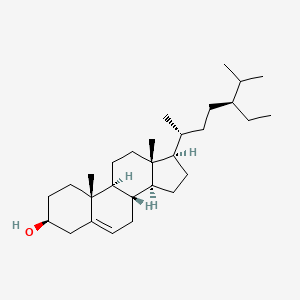
|
Clionasterol |
Clionasterol is a lipid of Sterol Lipids (ST) class. The involved functions are known as Intestinal Absorption. The related lipids are 22-hydroxycholesterol. |
711 |
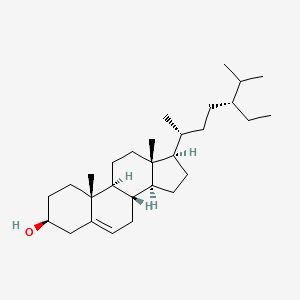
|
Beta-sitosterol |
Beta-sitosterol is a lipid of Sterol Lipids (ST) class. Beta-sitosterol is associated with abnormalities such as Obesity, Diabetes, Cholestasis, Systemic disease and Diabetes Mellitus. The involved functions are known as Increased Cholesterol Synthesis, Synthesis, cholesterol metabolism, GLUCOSE TOLERANCE and cholesterol absorption. Beta-sitosterol often locates in Blood, Back, Cell membrane, soluble fraction and Body tissue. The related lipids are Sterols, lathosterol, Total cholesterol, campesterol and Cholestanes. |
380 |
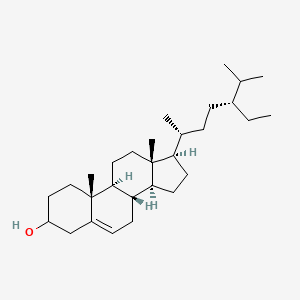
|
3beta-sitosterol |
|
234 |


































